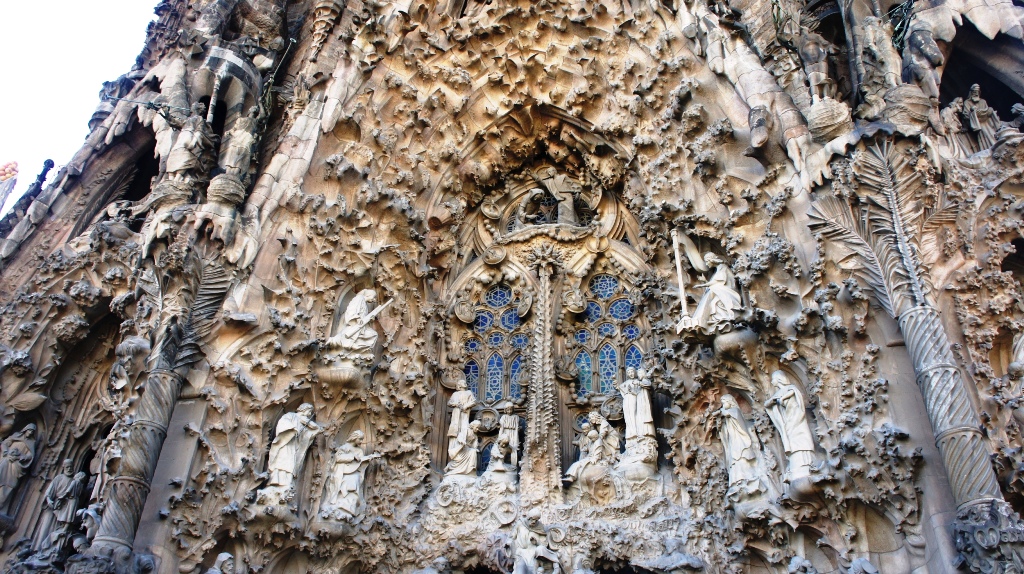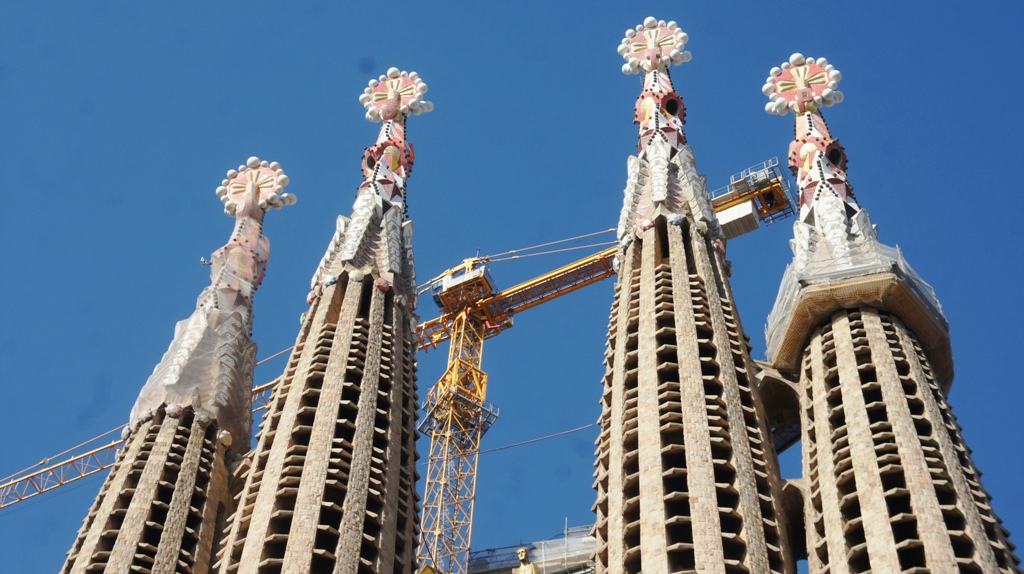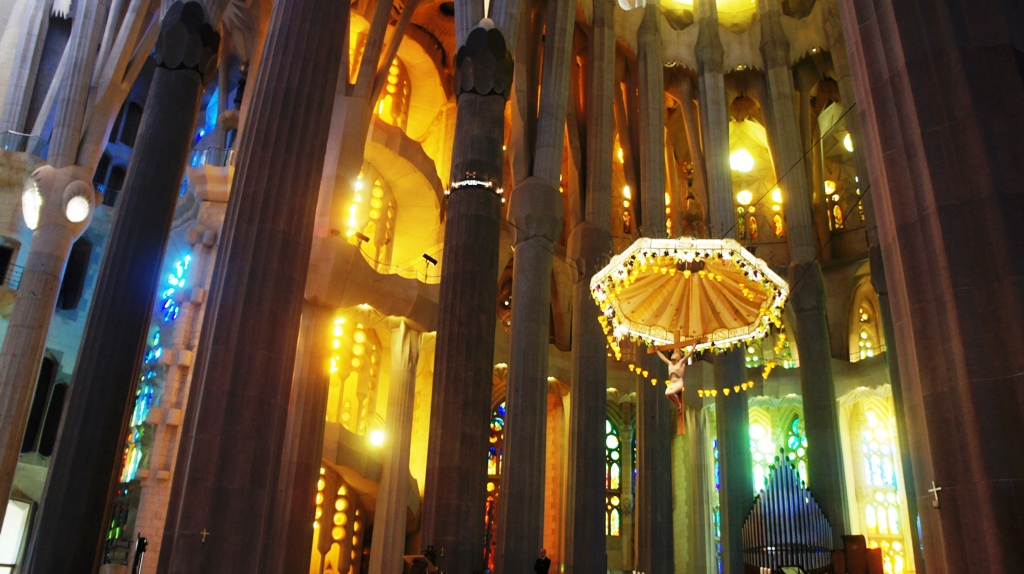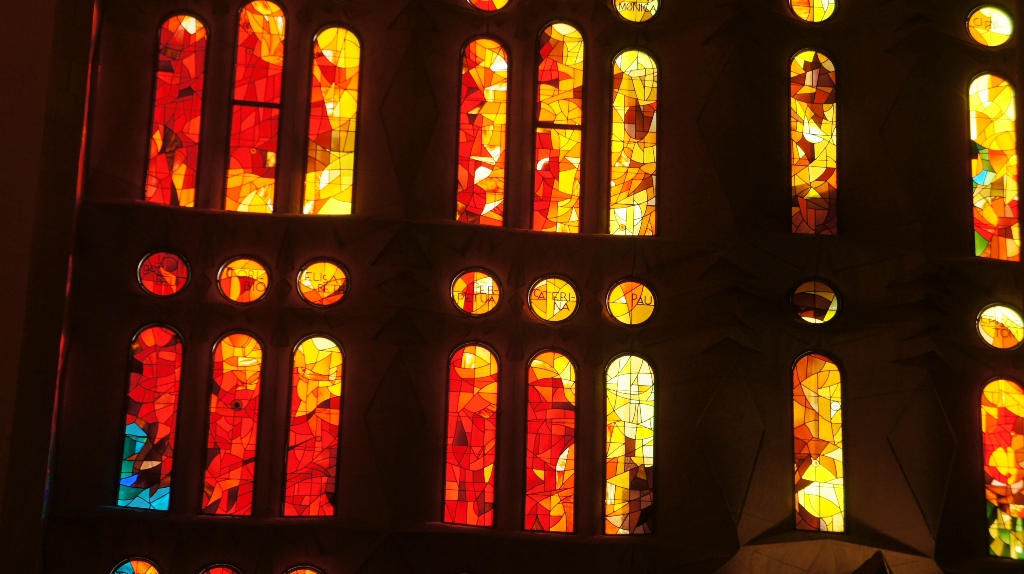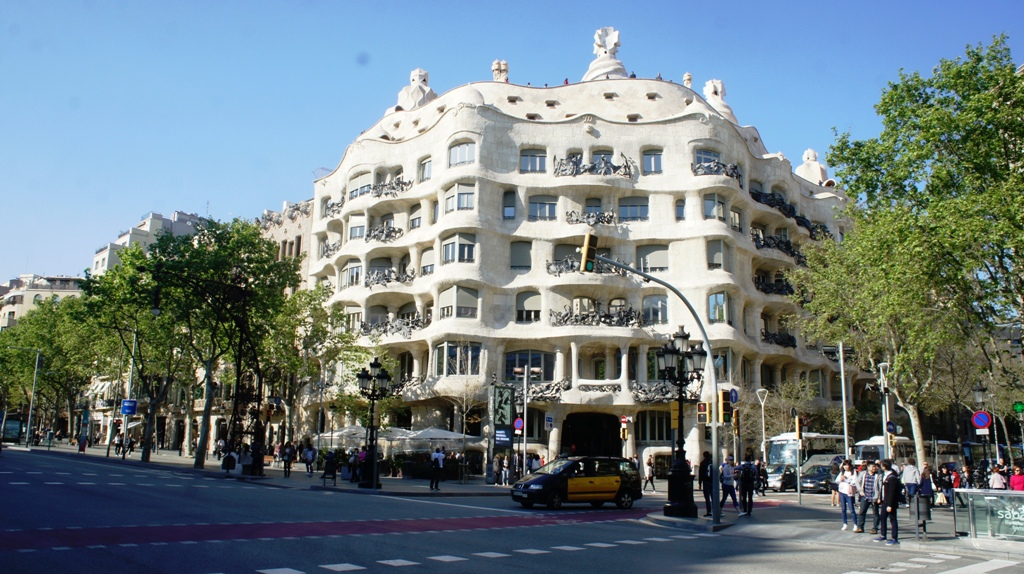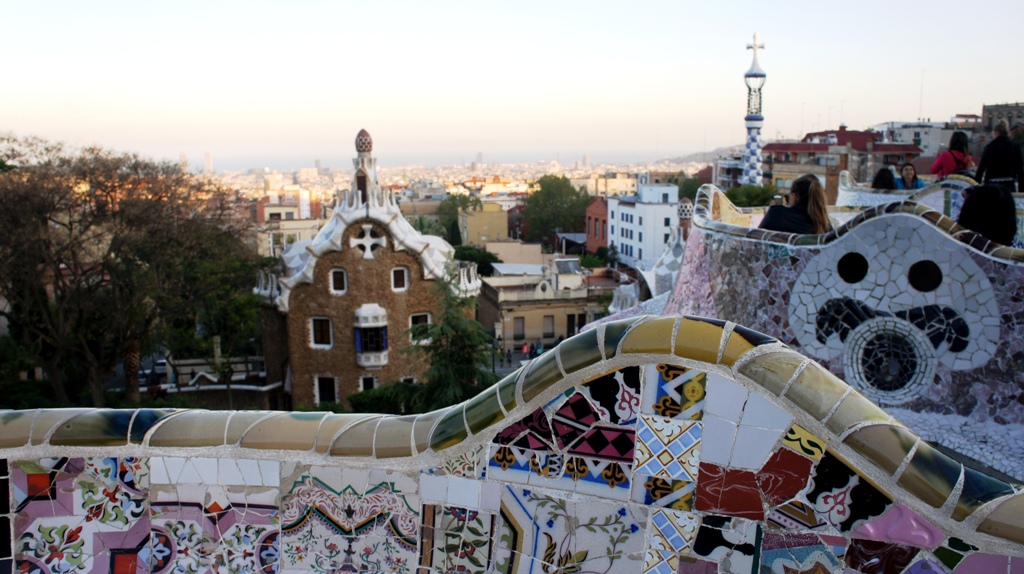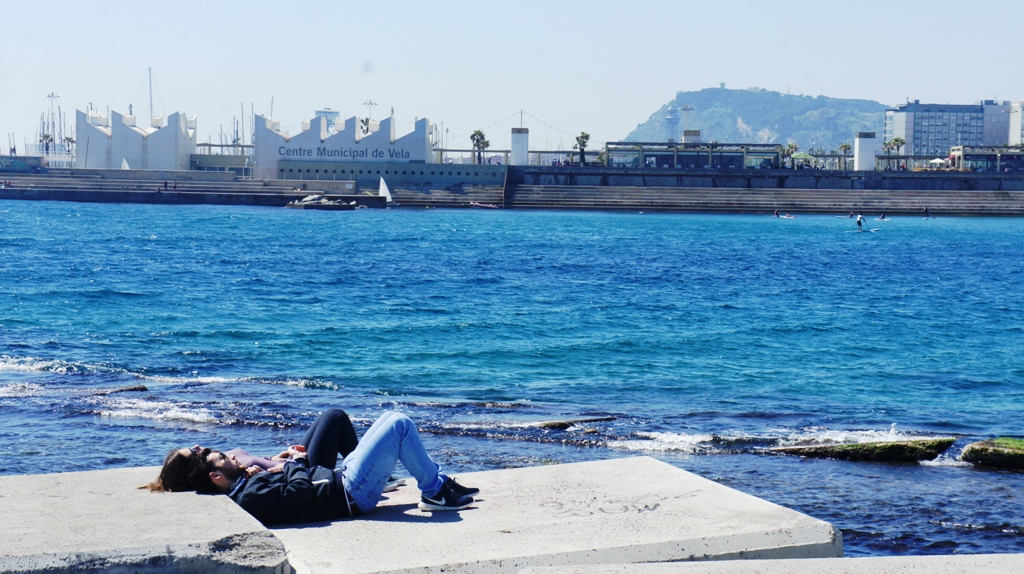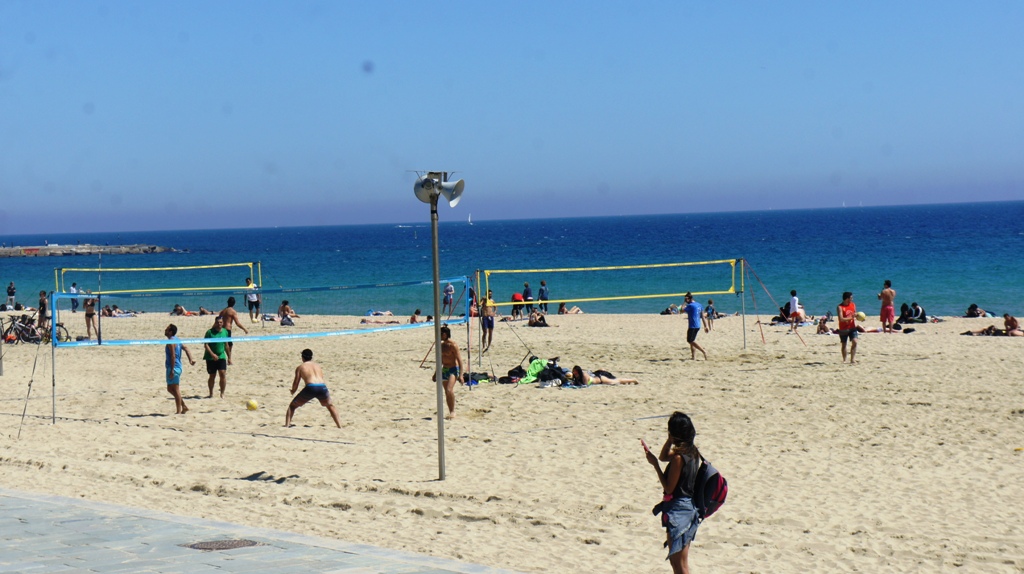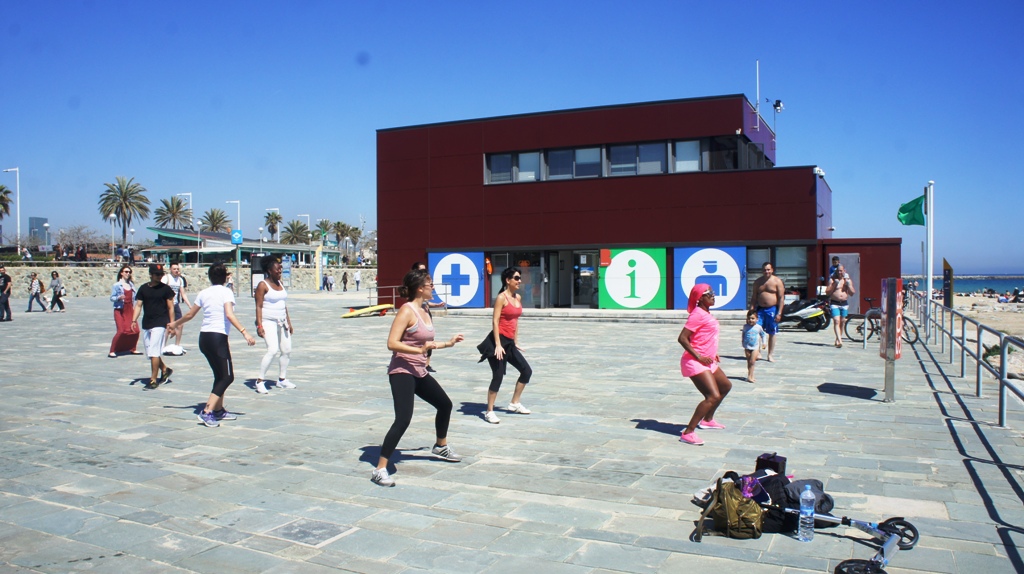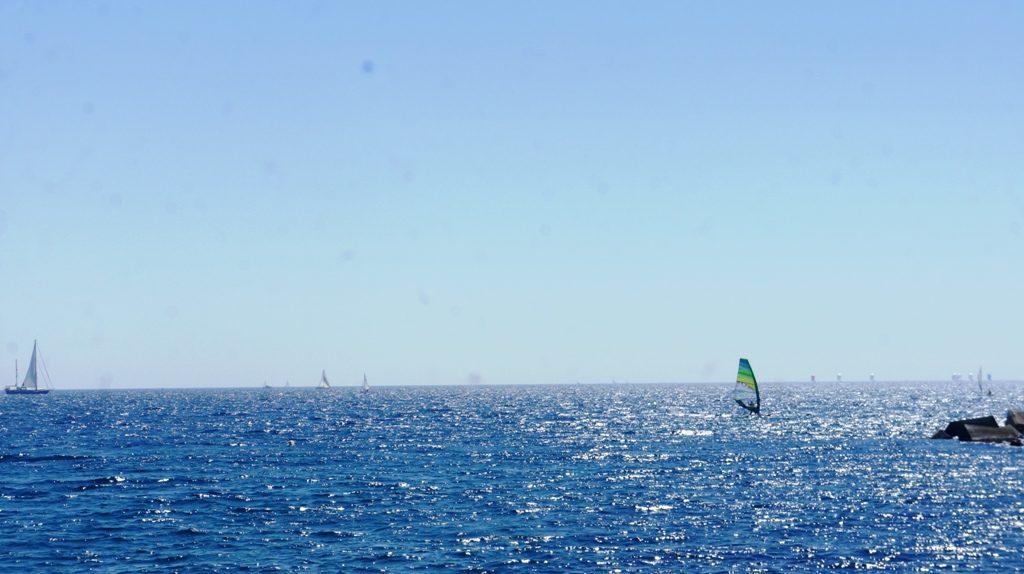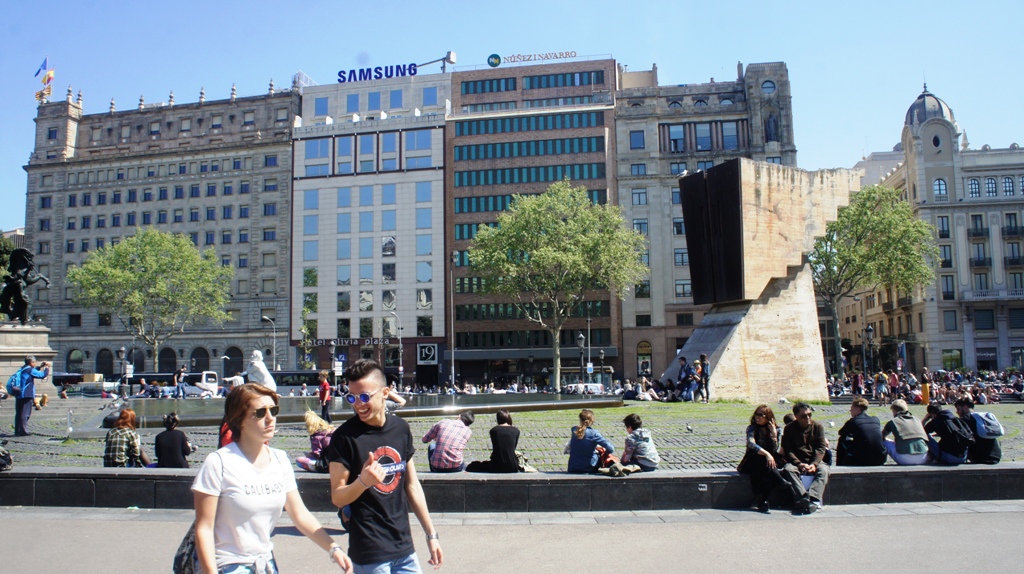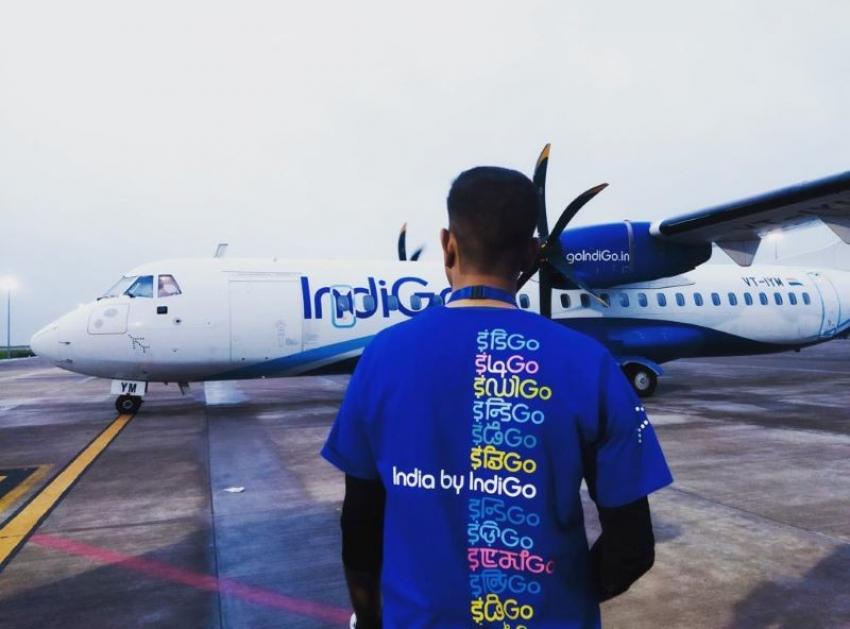Sujoy Dhar | @sujoydhar | 26 Nov 2017, 11:32 am
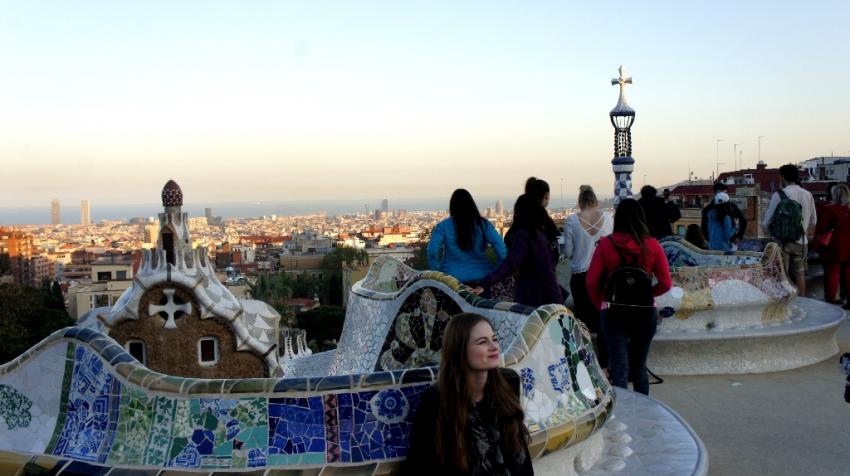
Park Guell is a public park system composed of gardens and architectonic elements in Barcelona designed by Gaudi
The mind-boggling Sagrada Familia, the unfinished Roman Catholic church in Barcelona designed by Catalan architect Antoni Gaudí, may be the pièce de résistance of this Catalan capital in Spain, but do not miss out the other Gaudi houses, says an awe-struck Sujoy Dhar
Every year a 1-mile run in Barcelona take runners 1.5 times round "The Basílica i Temple Expiatori de la Sagrada Família", the awe-inspiring church that rise up to the sky in the heart of Barcelona as the most audacious work of late Spanish Catalan architect Antoni Gaudí.
Said to be in the last state of its construction (more than 133 years in the making now) the fantastical Sagrada Família is Barcelona's most visited tourist attraction. So when in Barcelona you probably cannot miss this landmark.
Popularly known as the Gaudi church, it is a large Roman Catholic church, designed by Gaudí (1852–1926), a symbol of Catalan modernism for his adventurous, whimsical and exuberant works.
A UNESCO World Heritage Site now, the construction of this church had begun in 1882-3 and possibly it could end sometime between 2026 and 2032.
It bears the mark of Gaudi's architectural and engineering style, combining Gothic and curvilinear Art Nouveau forms.
Soaring towers, mind-blowing kaleidoscopic stained glass work and its intricate relief works of sculptures resembling an outgrowth of the stone, make this church a compelling visit if you are in Barcelona.
Gaudi’s counter-revolutionary philosophy into stone which once George Orwell had called ‘one of the most hideous buildings in the world’ actually is a huge crowd puller now.
While this temple of god was meant to be the cathedral for the poor, an expression derided by many because wealthy Catalan bourgeoise had patronized it and its famous architect, Gaudí felt the poor people were an object of prayer and not a subject for any revolutionary politics.
Gaudi was in no hurry to complete the church and he would say “my client is not in a hurry” referring to God while about the poor and pious people who would visit the church he had said that “a church [is] the only thing worthy of representing the soul of a people, for religion is the most elevated reality in man,”
The Nativity Façade of the church, completed in 1905, expresses the joy of the birth of Jesus, reflecting all the fantastical ideas of Gaudi.
The porticos are devoted to Mary, Joseph and Jesus representing faith, hope and charity.
This church has got more reviews on TripAdvisor (106,600) till April, 2017, crossing the figures of Eiffel Tower at 98,976 reviews.
While even a travel guide resource like Lonely Planet says "if you have time for only one sightseeing outing, this should be it [the church]”, generations of tourists are perhaps visiting this church to see it in a permanent state of being under construction.
But after a long queue- it attracts nearly 3 million visitors every year- as you enter inside the church, you see the synthesis of Gaudi's architectural theory and practice.
After you are awed by the parabolic shapes of the towers outside, inside you see the mind-boggling hyperbolic shapes of vaults.
Once completed the church will have 18 towers, the highest rising up to 170 metres and would therefore earn the distinction of being Europe’s tallest religious building, exceeding the height of Germany’s Ulm Minster.
But while the church is the most famous monument in Barcelona, a visitor’s Gaudi trail perhaps begins with other houses like Casa Batllo (1904-1905) and Casa Mila (1906-1912).
A visit to Casa Batllo is a must if you want to see how Gaudi restored a house and remodelled it avoiding any straight line .
The house in the traditionally upscale Barcelona is also called House of Bones for its visceral, skeletal organic design traits with the façade converted into a symbolic battle between Saint George and the dragon. Standing outside, Casa Batlló resembles a house made of skulls and bones. If the balconies are the "Skulls", then "bones" are the supporting pillars.
The interiors right from the wavy staircase rails to the windows and doors, he combined architecture with ornamentation. Do not miss the Gaudi roof, which is a world of shapes representing an animal’s spine with tiles of different colours.
Inspired by the colours of marine life Gaudi created a work of art which looks like a house made of natural coral.
The next house to visit is certainly Casa Milà, popularly known as ‘La Pedrera’ (the stone quarry).
This ironic allusion to the resemblance of its façade to an open quarry, was constructed between 1906 and 1912 by Gaudí. In 1984 it again was inscribed on UNESCO World Heritage List, for its exceptional universal value.
Nowadays it is the headquarters of Catalunya La Pedrera Foundation and houses a cultural centre that is a reference point in Barcelona for the range of activities it organises and the different spaces for exhibitions and other public uses it contains.
"Casa Milà today is a beacon shining with creation and knowledge, a great container full of content, which has a crucial role to play in the transformation of society and commitment to the people," says its website.
And yes do not miss out Park Guell (1900-1914), an attempt by Gaudi to create an urban development – a park- with no a single straight line.
According to the Park Guell official website, when it began to be built in 1900, Barcelona was a modern and cosmopolitan metropolis whose economy was based on the strength of its industry and which had over half a million inhabitants. Its walls had been knocked down nearly half a century earlier and the new city, the Eixample planned by engineer Ildefons Cerdà, had grown spectacularly from 1860 onwards, in what was the largest 19th century city development project in Europe.
The association between entrepreneur Eusebi Güell and architect Antoni Gaudí began when Güell saw a window display that Gaudí had planned for glove retailer Esteve Comella at the Universal Exhibition in Paris in 1878.
Park Güell is located in La Salut, a neighborhood in the Gràcia district of Barcelona. With urbanization in mind, Eusebi Güell assigned the design of the park to Antoni Gaudí and the park was built between 1900 and 1914 and was officially opened as a public park in 1926. In 1984, UNESCO declared the park a World Heritage Site under "Works of Antoni Gaudí".
The main attraction of the park is the main terrace with a long bench in the form of a sea serpent. The curves of the serpent bench form a number of enclaves, creating a more social atmosphere. Gaudí incorporated many motifs of Catalan nationalism, and elements from religious mysticism and ancient poetry, into the Park. Much of the design of the benches was the work not of Gaudí but of his often overlooked collaborator Josep Maria Jujol, according to articles.
The main entrance to Park Güell is on the south side, on Carrer d’Olot, from which visitors can enjoy the spectacular view of the stairway with the hypostyle room. The wall of the park is made of rustic stone topped with ceramic tiling and medallions bearing the name of Park Güell.
The iron gates, designed in the shape of palm leaves, do not form part of the original plan, but came from Casa Vicens. To either side are the two pavilions that form the porter’s lodge. The one to the left was the one actually used as a porter’s lodge, with a waiting room and telephone booth, while the one to the right was the porter’s residence, whence the name Casa del Guarda, though it is today part of the Barcelona History Museum. Both have very beautiful roofs, built with the traditional Catalan clay tiles covered with “trencadís”, a mosaic made of tile shards.
From the entrance esplanade a twin flight of steps soars up, flanked by two walls with merlons that form terraces under which there are two grottos. The one to the right was used for keeping the horses and is supported by a magnificent conical central column. The stairway is divided into three sections, along which the water from a fountain runs, once supplied from the tank under the hypostyle room. On the first landing are some capricious shapes like goblins, while halfway up the steps is the emblem of Catalonia and further up the dragon, or salamander, covered with decorative tile-shard mosaic which has become the most popular image of the park. On the last flight of steps, sheltered under the hypostyle room, is a Greek-theatre shaped bench.
Standing in the open terrace of Park Guell you can see a city before you melting with the horizon of Mediterranean and remember that an eccentric genius lived, worked and left his indelible mark here.
Barcelona Waterfront
If you are not as much a heritage and architecture enthusiast as a traveller as you love seafront, Barcelona offers you several cool beaches that stretch northeast from Port Olímpic (Olympic). The beach scene of Barcelona got a big boost with the 1992 Olympics when torrents of money flowed in to develop them. So besides Gaudi and Modernisme (Catalan modernism), spend ample time on the Barcelona waterfront. The Mediterranean waterfront of the Catalan capital offers breathtaking view of the sea while the seafront is also a hub of bustling seafood joints and waterfront bars. Svelte or buxom beauties in sexy swim suits or just topless sizzle the beaches as much as the hunky men with cool tattoo in their gym-crafted torsos. Spanning over 4 km, there are some seven beaches from the Old Port in the east to the Fòrum auditorium and exhibition centre in the west. The palm-lined promenade is a paradise for joggers, cyclists, beach volleyball players and walkers and you can spot people hip-swinging to pulsating music or may be grate-crashing into a zumba lesson to unwind themselves.
A READY RECKONER ON BARCELONA (Courtesy official tourism website)
About Barcelona:
The first human settlements in Barcelona date back to Neolithic times. The city itself was founded by the Romans who set up a colony called Barcino at the end of the 1st century BC. The colony had some thousand inhabitants and was bounded by a defensive wall, the remains of which can still be seen in the old town. For over 200 years, Barcelona was under Muslim rule, and, following the Christian reconquest, it became a county of the Carolingian Empire and one of the main residences of the court of the Crown of Aragon. The fruitful medieval period established Barcelona's position as the economic and political centre of the Western Mediterranean. The city's Gothic Quarter bears witness to the splendour enjoyed by the city from the 13th to the 15th centuries. From the 15th to 18th centuries Barcelona entered a period of decline. This struggle ended in 1714, when the city fell to the Bourbon troops and Catalonia's and Catalans' rights and privileges were suppressed. A period of cultural recovery began in the mid-19th century with the arrival of the development of the textile industry. During this period, which was known as the Renaixença, Catalan regained prominence as a literary language.
The 20th century ushered in widespread urban renewal throughout Barcelona city, culminating in its landmark Eixample district, which showcases some of Barcelona's most distinctive Catalan art-nouveau, or modernista, buildings. The Catalan Antoni Gaudí, one of the most eminent architects, designed buildings such as the Casa Milà (known as La Pedrera, the Catalan for stone quarry), the Casa Batlló and the Sagrada Família church, which have become world-famous landmarks.
Two days in Barcelona
On the first day, it's a good idea to go out and soak up the city's modernista ambiance. The best way to do so is to take the northbound Barcelona Bus Turístic to the Sagrada Família, where you'll discover the rich symbolic meaning of Gaudí's masterpiece. Just in front, on the avenue that bears his name, you will find the Modernist complex of Sant Pau Recinte Modernista, a place to discover the work of Modernist architect Lluís Domènech i Muntaner. Further up, at the Park Güell, you'll find the key to the Gaudiesque interplay between nature and architecture. At lunchtime, the neighbourhood of Gràcia is a wonderful option: you'll be surprised by its traditional neighbourhood feel, its wide variety of restaurants serving world cuisine, and combination of craft and design shops.
At 4pm, the walking tour Barcelona Walking Tours Modernisme is an excellent opportunity to enjoy a guided tour of the Passeig de Gràcia and the heritage district, the Quadrat d'Or. You'll see buildings such as Gaudí's Pedrera and Casa Batlló, and other landmarks by architects including Domènech i Montaner and Puig i Cadafalch, on an itinerary that will give you an in-depth understanding of this open-air modernista museum. At night, you'll be able to enjoy Barcelona's most modern facet if you have dinner in the Born. Here, you'll be able to see the church of Santa Maria del Mar, and be captivated by a neighbourhood which is a wonderful combination of medieval charm and Barcelona's hippest bars and restaurants.
On the following day, you can lose yourself in the Gothic Quarter, and if it's Friday or Saturday, you can "whet your appetite" on a Barcelona Walking Tours Gourmet which begins at 11am. This walking tour will allow you to savour Barcelona on a culinary trail through the old town, Ciutat Vella, which includes discovering the charms of the Boqueria Market, visiting some of Barcelona's oldest, landmark establishments, enjoying the famous chocolate houses on Carrer Petritxol, and sampling the typical produce of Barcelona's culinary culture.
After your walk, make the most of your time and let yourself fall under the spell of the architectural gems in the Gothic Quarter, such as the Cathedral in the Plaça Nova, the monumental ensemble in the Plaça del Rei, the civic and government buildings in the Plaça Sant Jaume, and the medieval charm of the streets around the Plaça del Pi. From here, you're just a stone's throw away from the shopping street, the Portal de l'Àngel, which is the perfect place to make a few purchases and recharge your batteries in one of the many restaurants in the area. In the afternoon, we invite you to continue visiting the north of the city on the northbound Barcelona Bus Turístic: while you relax in your seat, you'll be able to admire landmark buildings, including Pedralbes Monastery and the Futbol Club Barcelona Stadium.
To round off your stay, what about dinner in the old harbour, or Port Vell, as you enjoy the Mediterranean sea breezes? You can end the night here, at the leisure and entertainment complex, the Maremàgnum. You might feel tired by the end, but it'll have been well worth the effort.
Getting Around in Barcelona
Barcelona and its metropolitan area have a wide range of public transport and sightseeing transport options. There are different ticket types so that you can get to where you want to go in Barcelona easily and conveniently. Public transport such as the metro, tram and FGC are the quickest, simplest and most convenient way of getting around Barcelona. You can choose from the different ticket types and travel cards.
Metro, FGC and Tram
Public transport such as the metro, tram and FGC are the quickest, simplest and most convenient way of getting around Barcelona. You can choose from the different ticket types and travel cards.
Metro and FGC
Barcelona currently has eight metro lines that can be identified by the number and colour of the line: L1 (red), L2 (lilac), L3 (green), L4 (yellow), L5 (blue), L9 (orange), L10 (light blue), L11 (light green) and serve most of the city. It also has an urban and metropolitan rail network the Ferrocarrils de la Generalitat (FGC), run by the Catalan government, which supplements Barcelona’s metro network. There are three urban lines: L6, L7 and L8.
Tickets: methods and prices
The metro operates an integrated fare system enabling passengers to obtain a free transfer from one means of public transport to another within a period of 1 hour and 15 minutes. There are different types of travel cards and transport passes in Barcelona that are valid throughout the public transport network (metro, buses, tram and suburban rail), including the T-10 card which is valid for 10 journeys, or day passes (2, 3, 4 and 5 days).
Single Ticket: 2,15€
T-10 Card: 9,95€
Day passes: Hola Barcelona
Times
Metro (TMB): Weekdays from Monday to Thursday, Sunday and public holidays: 5am-midnight. | Friday and evenings before public holidays: 5am-2am. | Saturday and evenings before public holidays on 1/1, 24/6, 15/8 and 24/9: continuous service. | 24/12: until 11pm.
Ferrocarrils de la Generalitat (FGC): Weekdays from Monday to Thursday, Sunday and public holidays: 5am-midnight. | Friday: 5am-2am. | Saturday and evenings before public holidays on 1/1, 24/6 and 24/9: continuous service.
For further information about Barcelona's metro and rail services:
TMB: Tel. 933 187 074 | www.tmb.cat
FGC: Tel. 932 051 515 | www.fgc.cat
Tram
The Tram works again in Barcelona from 2004. This means of public transport, an alternative to the metro, that had disappeared in 1971, is today an accessible, ecological, fast and comfortable system.
The Tram route provides easy access to Barcelona's major industrial areas, shopping centres and residential zones.
There are 2 Tram lines in Barcelona: the Trambaix (T1, T2, T3) which runs from Francesc Macià to the towns of Sant Just Desvern, Sant Joan Despí, Sant Feliu de Llobregat and Cornellà. The Trambesòs (T4, T5, T6) covers a route from the Olympic Village to Sant Adrià de Besòs via the Forum site and arriving to Badalona.
Tickets: methods and prices
Single ticket: 2,15 €
T-10: 9,95 €
Day passes: Hola Barcelona
Times
Weekdays from Monday to Thursday, Sunday and public holidays: 5am-midnight. | Friday, Saturday and evenings before public holidays: 5am-2pm.
For further information about Tram services:
Tel. 900 701 181 | www.tram.cat
Bus
A fleet of over 1,000 fully adapted buses serve all areas of Barcelona. The integrated fare system means that travel cards can be used on the metro, trams, FGC and Renfe trains (zone 1)
Bus
Barcelona has a transport fleet of more than 1000 buses which operate on over 80 routes and connect all the city's districts and the metropolitan area. The buses have low floors and are adapted for people with reduced mobility. Transport passes can be used on the metro, Barcelona's tram, city-centre lines of the Ferrocarrils de la Generalitat (FGC) and Renfe trains (zone 1).
Tickets: methods and prices
Barcelona's bus network operates an integrated fare system enabling passengers to obtain a free transfer from one means of transport to another within a period of 1 hour and 15 minutes. There are different types of travel cards and transport passes that are valid throughout the public transport network (metro, buses, tram and suburban rail), including the T-10 card which is valid for 10 journeys, or day passes (2, 3, 4 and 5 days).
Single ticket: 2,15 €
T-10: 9,95 €
Day passes: Hola Barcelona
Times
Running times vary according to the bus route. Most services begin at 4.25am and end at 11pm. Average frequency of service is between 20 and 30 minutes at weekends. (The running times and frequency of service are posted at the bus stops).
For further information about Barcelona's bus network:
Tel. 933 187 174 | www.tmb.cat
Night Bus Service
Barcelona has a night-bus service (Nit Bus) which serves most of the city and its suburban area.
Most of the night bus services begin between 10.40pm and 11.40pm and end between 5am and 6am. They all stop at or depart from Barcelona's Plaça de Catalunya.
For further information about Barcelona's night bus network, methods, prices and times: www.emt-amb.com
Taxis:
Barcelona has a service of 11,000 taxis which can be easily identified by their yellow and black livery. A green light on top of the taxi indicates its availability. There is also a service of taxis adapted for people with reduced mobility.
If you want to hire specific services (drivers who speak foreign languages, seven-seater vehicles, etc.), we recommend you use the telephone booking service.
Barcelona taxi fares
- There are special supplements of entrance and exit of the airport, luggage and nights.
For further information about taxis service of Barcelona:
Institut Metropolità del Taxi de Barcelona
Tel. 932 235 151
Bicycle
An original and different means of transport to discover the city. Barcelona has fully integrated cycle lanes and you can cycle through the city's open spaces and parks.
1 - 10 from 40
AJO BIKE
Contact details : 08001, d'en Roig, 5, Barcelona | Tel: 930 082 298 | Web: www.ajobikerentbarcelona.com
AL PUNT DE TROBADA
Contact details : 08005, Badajoz, 28 bis, Barcelona | Tel: 932 216 367 | Web: www.alpuntdetrobada.com
BARCELONA BCN TRAVEL
Contact details : 08002, Moles, 22, Barcelona | Tel: 934 121 597 | Web: www.bcn.travel
BARCELONA BIKE TOURS (Singular Projects)
Bike Tours Architect-guided.
Contact details : 08024, C. Mercedes 15, Barcelona | Tel: 936 670 241 | Web: www.singularprojects.cat/page2.php
BARCELONA BIKING
Contact details : 08002, Baixada Sant Miquel, 6, Barcelona | Tel: 656 356 300 | Web: www.barcelonabiking.com
BARCELONA BY BIKE
Contact details : 08005, Escullera del Poble Nou 298-299. Port Olimpic, Barcelona | Tel: 932 688 107 | Web: www.barcelonabybike.com
BARCELONA CICLOTOUR
Contact details : 08001, Tallers, 45 - Local interior, Barcelona | Tel: 933 171 970 | Web: www.barcelonaciclotour.com
BARCELONA E-BIKE RENT
Electric bikes
Contact details : 08002, Cervantes, 5, Barcelona. | Tel: 933 106 133 | Web: www.e-bikerent.com
BARCELONA EXPERIENCE
Contact details : 08027, Josep Estivill, 56, Barcelona | Tel: 650 012 894 | Web: www.barcelonaexperience.com
BARCELONA HOLIDAY BICI
Contact details : 08002, Passatge dels Escudellers, Local 3, Barcelona | Tel: 933 026 481 | Web: www.barcelonaholidaybici.com
Hop on – Hop off Buses in Barcelona
For tourists, this is the best way to get around and visit the tourist attractions. Nothing like a hop on hop off bus. Choose either the white-green Bus Turistic or the red buses from Barcelona city tour. The three routes take you to all of Barcelona´s famous landmarks. Get on and off as many times as you want with a single ticket. Touring Barcelona doesn’t get easier!
On board of both Barcelona tour buses multi-language audio guides will give you a brief overview of the things to see along the routes and the upcoming stops. Buy tickets online avoiding queue and avail of discounts.
Barcelona hop on hop off Bus Turistic: 26,10€ per day one adult
Barcelona Red Bus: 26,10€ per day one adult
(Part of the article by the same author was published in The Tribune newspaper earlier. Alll images by Sujoy Dhar)
- From Kennedy’s Proposal to 1850s Saloons: The Three Historic D.C. Restaurants Everyone Must Try
- This city has the best bagel in the US, and it’s not New York!
- I escaped to Pachmarhi — what I found in the queen of Satpura left me spellbound
- Air Canada just ranked the Best New Restaurants of 2025 - And the Top Spot isn't who you think
- Rediscovering Arunachal's Monpa Cuisine: One Woman’s Millet Momo Revolution
- Discovering Heritage: A visual journey through Odisha crafts museum Kalabhoomi
- From kebabs to biriyani: Lucknow gets UNESCO honour for its royal cuisine
- Delta takes Spanish flavours to the skies
- Kolkata’s iconic Kathi Roll among world’s top 10 wraps: TasteAtlas
- Yellow Taxis and the Colours of Puja
Air Canada has introduced a new non-stop route connecting Toronto with Rio de Janeiro, with the first flight landing in the Brazilian city on Friday morning.
Air India, India’s leading global airline, and Maldivian, the national airline of the Maldives, have entered a bilateral interline partnership aimed at boosting connectivity between the two countries.
IndiGo, India’s largest airline, is grappling with one of its most severe operational crises in recent years, with widespread flight delays and cancellations disrupting travel across the country for a second consecutive day.

